Meifod is a small village and community which lies some seven miles north-west of Welshpool in the county of Montgomeryshire, on the A495 road. The village is situated in the valley of the River Vyrnwy and is near to the site of the ancient royal residence of the Princes of Wales at Mathrafal. The village is centred around its Parish Church, which is dedicated to St Tysilio and St Mary. The men, and one woman, of the village who fell during both World Wars, are commemorated on two separate memorial plaques, which are affixed to the wall of the Church tower.
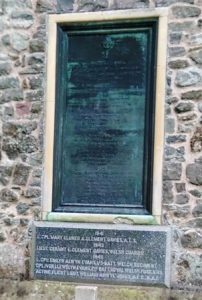
The Great War, 1914-1918
David Bowen, Private, G/15602, Royal Fusiliers. David was the son of John Bowen and Jane Ellen Bowen, of Maesgwyn, Guilsfield. He worked for his uncle, Richard Bowen, at Moss Farm Redcliffe Road, Barton, Patricroft prior to the war. David enlisted at Manchester into the Royal Field Artillery soon after the outbreak of war, but then transferred to the 2nd Battalion, Royal Fusiliers. The battalion had been among the first units which landed at Gallipoli on 25 April 1915 and was attached to 86 Brigade, 29th Division. It saw heavy fighting over the coming days, suffering heavy casualties as the Allies attempted to advance from the landing beaches, but were kept at bay by the Turks. David joined the battalion at Gallipoli later on in the campaign, embarking on 24 October 1915 and saw out the final months on the peninsula before the Division was evacuated to Egypt on 11 January 1916. The Division then transferred to the Western Front on 15 March 1916, taking over positions on the Somme front, opposite Beaumont Hamel. The Division took part in its first major action in France during the 1916 Somme Offensive, assaulting Y-Ravine on 1 July 1916 and suffered terrible casualties during the day. The Division was then pulled out of the line to rest and rebuild before moving back into the line and taking part in the latter stages of the Somme offensive. On 3 December 1916 the 2nd Royal Fusiliers relieved the 2nd Hampshire’s in the front line to begin a routine tour in the trenches. By now the Somme offensive had fizzled out and normal trench warfare had resumed. This tour was to prove a relatively quiet one, but David was killed in action on 7 December 1916 just before the battalion was relieved. The 27-year-old has no known grave and is commemorated on the Thiepval Memorial, France. His brother, Edward, died whilst on active service just over two months later.
Edward Bowen, Private, 203663, Royal Welsh Fusiliers. Edward was the son of John Bowen and Jane Ellen Bowen, of Maesgwyn, Guilsfield. He worked as a waggoner prior to enlisting into the 4th Battalion, Royal Welsh Fusiliers at Welshpool on 11 December 1916 and was initially placed on the Army Reserve. Edward was mobilised on 21 January 1917 and attested at Wrexham before being posted to Park Hall Camp, Oswestry for training. Edward had been at Park Hall less than a month before he took ill and was admitted to Oswestry Military Hospital, suffering from bronchitis. His condition worsened over the coming days, and he died of bronchitis there on 27 February 1917. The remains of the 22-year-old were brought home for burial in Saint Tysilio and Saint Mary’s Churchyard, Meifod.
William Henry Corbett, Private, 17292, King’s Shropshire Light Infantry. William was born at Chirk on 19 July 1883, the son of Samuel and Clara Corbett. He married Annie Evans in 1911 and the couple set up home together at Pen-y-Coed, Meifod, where William worked as a domestic gardener. William enlisted at Shrewsbury into the 7th Battalion, King’s Shropshire Light Infantry soon after the outbreak of war. The battalion embarked for France on 28 September 1915, attached to 76 Brigade, 25th Division, but two weeks later, 76 Brigade transferred to the 3rd Division, in the Ypres Salient. Arthur did not embark with the battalion at the time but joined among a number of reinforcements early in 1916. The 3rd Division was holding a sector of the line near Hill 60, which included a feature known as The Bluff. During February and March 1916, a series of fierce actions took place for the Bluff, which afforded a height advantage over the battlefield to the force holding it. The 3rd Division suffered heavy casualties during this period, and then suffered more during the ensuing Actions of the St. Eloi Craters, when the British and Germans fought for control of a series of six craters which had been formed by the blowing of underground mines. The 3rd Division moved south afterwards, to take part in the Somme offensive, the 7th KSLI reaching Carnoy by 7 July. The Division took part in its first major action on the Somme a week later, when it attacked Bazentin Ridge. The 7th KSLI suffered terrible casualties during the assault, with almost 500 officers and men killed or wounded. The battalion went back into reserve at Montauban and then to Méaulte to rebuild, before moving back into the line to support an assault by the 10th RWF on Maltzhorn Farm on 18 August 1916, before capturing Lonely Trench the following day. The Division was then relieved, moving north to Mazingarbe, before returning to the Somme and taking part in a disastrous assault upon the village of Serre on 13 November. The Division remained in this sector until 7 January when it moved to the Arras Sector, and on 9 April 1917 took part in the opening assault of the Battle of Arras. The Battle raged over the coming weeks, with the 3rd Division in the thick of the fighting around the village of Monchy. William was badly wounded here and died of his wounds on 28 April 1917. The 34-year-old is buried in Duisans British Cemetery, Étrun, France.
Henry Davies, Private, 203617, Royal Welsh Fusiliers. Henry was the son of John and Margaret Ellen Davies, of Meifod. He lived at The Belan, New Mills, Manafon prior to the war and worked there as a shepherd. Henry enlisted into the 4th Battalion, Royal Welsh Fusiliers at Welshpool on 12 December 1915 and was initially placed on the Army Reserve. He was mobilised in January 1917 and attested at Wrexham before being posted to Park Hall Camp, Oswestry for training. Henry embarked for Egypt on 12 July 1917 to join the EEF and on 11 August 1917 was posted to the 24th Battalion, Royal Welsh Fusiliers. The battalion had been formed from the Denbighshire Yeomanry in Egypt on 1 March 1917, joining 231 Brigade, 74th (Yeomanry) Division, and saw its first major action during the Second Battle of Gaza on 17 April. The battle was a failure, and the EEF was re-organised under a new commander, Sir Edmund Allenby, before launching the Third Battle of Gaza on the night of 31 October 1917. This assault was launched along a winder front, running from Gaza to Beersheba, and this time the EEF prevailed, opening the door to Jerusalem. The Division then took part in the drive north into Syria, but as a result of the heavy losses suffered in France, following the launching of the three German Spring offensives from 21 March 1918, was sent to France, landing in Marseilles on 7 May 1918. The Division underwent a system of training, to prepare it for the vastly different conditions on the Western Front, before taking over a section of the front in the St. Floris Sector. On 25 July the 24th RWF moved into reserve positions here for the first time, and began work in support of 92 Brigade, which was holding the line. On 23 July 1918 the 24th RWF was positioned at Vieux Berquin when it was subjected to an intense artillery bombardment. Henry was the sole man killed by the bombardment that day. The 24-year-old is buried in Le Grand Hasard Military Cemetery, Morbecque, France.
David Evans, Second Lieutenant, Royal Engineers. David was the son of John and Mary Evans, of Upper Main, Meifod. He was educated at Llanfyllin County School before serving an apprenticeship as architect at Oswestry. David then gained a position in the Land Valuation Office at Welshpool. He was commissioned as Second Lieutenant into the Royal Engineers in November 1915 and embarked for France in August 1916, joining the 1st Siege Company (Royal Anglesey), Royal Engineers, which was working at Rue De Tannay, near Bethune, on 21 August. The Company was busy working on trench repairs, building parapets, repairing breastworks and laying trench boards in the line east of Factory Post. The Company was carrying out this work on 14 September 1916 when David was accidentally killed. The 22-year-old was buried in Vieille-Chapelle New Military Cemetery, Lacouture, France.
Robert William Griffiths, Private, 3590, Welsh Guards. Robert was born in 1898, the son of Evan and Mary Griffiths, of Elm Cottage, Meifod. Prior to the war the family moved to 4, Rose Cottages, Llansantffraid. He enlisted into the Welsh Guards at Welshpool and was drafted to France in the summer of 1917 to join the 1st Battalion, Welsh Guards, which was attached to the 3rd Brigade, Guards Division. The division had remained in the Somme sector over the winter of 1916-17, and in March 1917 took part in the advance caused by the German Retreat to the Hindenburg Line. Later that year the Division moved north to Ypres and fought at the Battle of the Pilckem Ridge, the opening phase of the Passchendaele offensive. The Guards Division saw further fighting at Ypres, during the later stages of the offensive, being in support for an assault by the Guards Division towards the Broombeek on 10 October, before advancing the line on the following day. The Guards Division was relieved soon afterwards, moving to Serques to rest and rebuild, before being moved south on 9 November, to take part in the Battle of Cambrai. By 23 November the Guards had taken over the Flesquières sector, to bolster its defences following the launching of a German counterattack which had been launched on the previous day. Heavy fighting then ensued over the coming days, some of the fiercest of which the Guards has seen since the beginning of the war. Robert was killed in action near Gouzeaucourt on 1 December 1917, in a terrible day of fighting which saw the Welsh Guards suffer 270 casualties. The 19-year-old has no known grave and is commemorated on the Cambrai Memorial, Louverval, France.
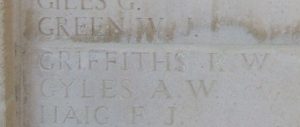
John Howard Jehu, Lieutenant, Middlesex Hussars. John was born at Meifod in July 1889, the son of John Jehu and Elizabeth Jehu (nee Griffiths), of The King’s Head Hotel. John worked at the Hotel for his mother following his father’s death in 1910. He enlisted at Welshpool into the Montgomeryshire Yeomanry. On 5 August 1914 the Montgomeryshire Yeomanry was mobilised at Welshpool, as part of the South Wales Mounted Brigade, before moving via Hereford to Thetford in Norfolk, to join the 1st Mounted Division. John and had risen to the rank of Squadron Sergeant Major before being discharged to a commission as Second Lieutenant into the 1st County of London Yeomanry, Middlesex Hussars, on 27 October 1915. The regiment was also in Norfolk, in the North Walsham area but in April 1915 had embarked for Egypt before landing on Gallipoli with the 2nd Mounted Brigade. John did not embark for overseas until early 1916 by which time the Middlesex Hussars had been evacuated to Egypt and was attached to the 8th Mounted Brigade of the EEF, on the Suez Canal Defences. The EEF then turned its attention onto driving the Turks out of Palestine, and on 26 March 1917 launched its first offensive against the coastal city of Gaza, which guarded the road to Jerusalem. Initial gains during the day were lost when the assaulting divisions lost touch with each other, and communication broke down when a thick fog cloaked the battlefield. A second attempt to force Gaza was launched on 17 April, which also failed, and the EEF suffered a change in leadership, with Sir Edmund Allenby assuming command, before being re-organised, and a third offensive was launched against a wider front from Beersheba to Gaza on 31 October 1917. This time the Turkish defences were breached, and the road to Jerusalem now lay open and the EEF began to advance north, launching an attack on the Khuweilfeh Heights, and once secured, the EEF continued its advance into the Judean Hills, capturing Hebron and Bethlehem, before securing the Jerusalem to Jericho Road. John was killed during a Turkish counterattack, near Nebi Samwil, on 28 November 1917. The 28-year-old is buried in Jerusalem War Cemetery, Israel.
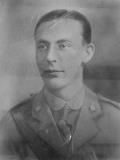
Charles Jones, Private, 12099, King’s Shropshire Light Infantry. Charles was the son of William and Mary Ann Jones, of Lundy Cottage, Meifod. He enlisted into the 6th Battalion, King’s Shropshire Light Infantry at Shrewsbury soon after the outbreak of war. The battalion had formed at Shrewsbury in September 1914, before joining 60 Brigade, 20th (Light) Division at Aldershot. In April 1915 the Division moved to Larkhill, Salisbury Plain and on 22 July 1915 landed at Boulogne. The Division then moved to the Fleurbaix Sector, for trench initiation alongside the 8th Division. When the Battle of Loos was launched on 25 September 1915 the Division fought a diversionary attack towards Fromelles and the 5th KSLI alone lost 63 men killed or wounded. In January 1916 the Division was relieved from the Fleurbaix sector and moved north into the Ypres Salient, taking over positions on the Canal Bank by 11 February. At 02.00 on the following morning, 12 February 1916, the 6th KSLI was in the front line when a German raiding party hit the neighbouring battalion, and the entire line was subjected to a fearsome artillery barrage. Charles was among seventy casualties suffered by the battalion that morning when he was killed by a shell burst. The 27-year-old is buried in Artillery Wood Cemetery, Belgium.
Evan Jones, Private, 6600, King’s Shropshire Light Infantry. Evan was the son of John Jones, of Meifod. He enlisted into the King’s Shropshire Light Infantry as a young man prior to the war and was a Special Reservist. Evan embarked for France on 20 May 1915, joining the 2nd Battalion, King’s Shropshire Light Infantry, which was at Ypres attached to 80 Brigade, 27th Division. By then the Division was holding the Bellewaarde Sector, east of Ypres. Evan joined the 2nd KSLI on the following day, 21 May, as part of a draft of 130 men, whilst the battalion was in bivouacs near Busseboom resting. The Second Battle of Ypres opened on the following day, when the Germans released a huge discharge of some 171 tons of chlorine gas on the sector of front at Gravenstafel held by a French Colonial unit and the surviving French fled in terror as their compatriots fell dying to the ground in sheer agony. A huge gap opened up in the line which was filled by the advance of the Canadian Corps and terrible fighting ensued. On 24 May the battalion received orders to prepare to move due to the 28th Division and the 4th Division being under a gas attack at Bellewaarde, and the Germans had advanced and captured their positions. The 2nd KSLI, and the remainder of the 27th Division, was ordered to move forward and retake the lost positions. During the afternoon the 2nd KSLI moved forwards along the Ypres to Roulers railway, taking up position in the G.H.Q. line, then at 01.00 on the following morning, 25 May 1915, launched an assault against the Germans at Bellewaarde. Evan was killed in action during the assault that morning, just four days after arriving at the front. The 18-year-old has no known grave and is commemorated on the Ypres (Menin Gate) Memorial, Belgium. The 2nd KSLI alone had suffered 200 casualties during the day.
Percy Bourne Jones, Private, 40164, South Wales Borderers. Percy was the son of Pryce and Mary Jones, of Blossoms, Meifod. He enlisted at Welshpool into the 3/7th Battalion, Royal Welsh Fusiliers, and was posted to Park Hall Camp, Oswestry for training. Percy was drafted to France in the winter of 1917-18, joining the 6th Battalion, South Wales Borderers, which was the Pioneer Battalion to the 25th Division. Percy joined the battalion at Fremicourt, near Lagnicourt, where the men were at work on the Intermediate Line, digging trenches and excavating dugouts. On 12 February 1918 the 6th SWB moved back to Achiet-le-Grand, where the men enjoyed several weeks rest, and celebrated St. David’s Day, before beginning work again. The 6th SWB moved forwards into the Favreuil sector on 13 March and began work in the forward areas again. At dawn on 21 March 1918, the Germans launched the first phase of their Spring offensive along this sector, on a front running from Croisilles to La Fère, and broke through along the entire front. The men of the 6th SWB were at work excavating dugouts in Favreuil Wood when the offensive opened, and the men were forced to revert back to their infantry role, taking part in heavy fighting over the coming days, whilst withdrawing towards Hébuterne. The battered division was then transferred north, to the Ploegsteert sector to rest, but unfortunately became caught up in the second phase of the German offensive, on the Lys, from 9 April, and again suffered terribly. The Division withdrew to Abeele on 17 April, but on 25 April was ordered back into the line, and took part in the Second Battle of Kemmel. On 9 May the division moved to Fismes, 20 miles south-east of Soissons in the Champagne, to give it a chance to rest and rebuild again. However, on 26 May the division took up positions south of the Aisne, to guard against a predicted German Offensive. On 27 May 1918 the attack hit them, and during the coming days the Division was virtually annihilated and was broken up. As a result, on 2 July 1918 the 6th SWB transferred to the 30th Division, in the Ypres Salient. On 8 August the Allies gained a huge victory over the Germans at Villers Bretonneux on the Somme, and from 21 August onwards went on the offensive. The 30th Division took part in the Advance in Flanders, and then at the Battle of Ypres and the Battle of Courtrai. Percy took ill towards the end of the war and died of influenza in Belgium on 25 October 1918. The 21-year-old is buried in Lijssenthoek Military Cemetery, Belgium. Percy is not commemorated on the Meifod war memorial but is commemorated at nearby Bwlch-y-Cibau.
Pryce Jones, Private, 201373, King’s Shropshire Light Infantry. Pryce was the son of John and Martha Jones, of Gwernycil, Meifod. He moved to Shawbury as a young man and worked there as a servant for many years prior to the war. Pryce enlisted at Shrewsbury into the King’s Shropshire Light Infantry and was posted to the 1/4th Battalion, King’s Shropshire Light Infantry. The battalion was a territorial Army unit, which had spent much of the war on garrison duty split between Singapore, the Andaman Isles and Hong Kong. The battalion re-united in Singapore in April 1917 before sailing back to Britain, landing at Plymouth. On 27 July the battalion re-embarked at Southampton and landed at Le Havre, before joining 190 Brigade, 63rd (Royal Naval) Division at Arras the following month and for the first time during the war, the 4th KSLI moved into the trenches near Oppy Wood. On 2 October the Division was relieved and entrained for the Ypres Salient, to join the great Passchendaele offensive. The 4th KSLI then moved forwards to Irish Farm, some four miles northwest of Ypres before advancing to Albatross Farm on 29 October and taking over positions in the front line, suffering some 30 casualties from artillery fire during the relief. At 13.30 on the following morning, 31 October 1917, the 4th KSLI launched an assault on Source Trench, to fill a gap in the line near Varlet Farm and supplied one company at the disposal of the Canadians on the right at Kronprinz Farm. Conditions were terrible as the men waded forwards through the thick mud and the battalion suffered almost 140 casualties during the day. Pryce had been killed in action at some time during the advance that day. The 38-year-old has no known grave and is commemorated on the Tyne Cot Memorial, Belgium. His brother, Richard Llewellyn Jones, died as a result of gas poisoning on 19 October 1915.
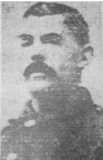
Richard Llewellyn Jones, Private, 2079, Cheshire Regiment. Richard was the son of John and Martha Jones, of Gwernycil, Meifod. He worked for his uncle, William Pugh, at Penrhos Farm, Llanymynech prior to travelling to Birkenhead to enlist into the 1/5th Battalion, Cheshire Regiment soon after the outbreak of war. The battalion was mobilised at The Drill Hall, Volunteer Street, Chester as part of the Cheshire Brigade, Welsh Division. It then moved to Shrewsbury before moving to Northampton with the Division. During February 1915 the 5th Cheshire’s left Welsh Division and landed at Havre on 15 February 1915, joining 14 Brigade, 5th Division at Neuve Eglise. The battalion moved into the front line here for the first time on 22 February for trench instruction then a month later the battalion took over a section of front line at Kemmel by itself for the first time. At the beginning of April, the Division moved north and took over trenches east of Ypres, near Dickebusch. The Second Battle of Ypres opened on 22 April, when the Germans released a huge discharge of some 171 tons of chlorine gas on the sector of front at Gravenstafel held by a French Colonial unit and the surviving French fled in terror as their compatriots fell dying to the ground in sheer agony. A huge gap opened up in the line which was filled by the advance of the Canadian Corps and terrible fighting ensued. The 5th Division was by now holding the line at Kruisstraat and saw heavy fighting here until the battle eased on 25 May. The Division remained at Ypres until being relieved in July 1915 and moved south to Daours, then took over a section of the front line on the Somme, at Suzanne, from the French in August. Richard was wounded at some time between Second Ypres and the move to the Somme and was invalided home, suffering from gas inhalation. He died in hospital at Chester on 19 October 1915. The 21-year-old is buried in Chester (Overleigh) Cemetery. His brother, Pryce Jones, was killed at Ypres on 31 October 1917.
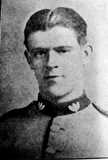
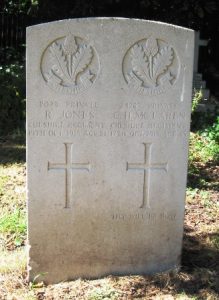
Walter Jones, Private, 15849, South Lancashire Regiment. Walter was the son of William James Jones and Ellen jones, of Pentre, Meifod. He worked as a porter in a hotel in Liverpool prior to enlisting in the city into the South Lancashire Regiment on 9 November 1914. He initially joined the Depot at Fulwood Barracks, Preston before being posted to the 7th Battalion, South Lancashire Regiment on 18 November. The battalion was at Tidworth attached to 56 Brigade, 19th (Western) Division. Walter embarked at Folkestone for France with the battalion on 19 July 1915, and the entire 19th Division then moved to the Nursery Sector at Calonne for trench initiation alongside the Dehra Dun Brigade. The infantry battalions of the division then began carrying out the usual routines of rotating in the trenches: four days in the front line; four in support; and four in reserve, interspersed with training regimes and carrying out working parties and trench raids. Just south, the British launched a great offensive around the town of Loos on 25 September 1915, and the 19th Division was ordered to attack from its positions at the same time, to attempt to draw enemy attention away from the main battle area. The attacking battalions of the 19th Division were in place by 04.00, and then at 05.50 the men climbed out of their trenches to launch their assault, behind a gas and smoke screen. The assault was a disaster, and heavy casualties were suffered by the 19th Division for no gain. The battered division remained in the area over the coming months until being relieved in April 1916 and began to move south to the Somme sector, reaching Albert by 20 May. The Divisions infantry battalions then spent several periods behind the lines training for the forthcoming Somme offensive, before moving into support positions by 30 June. At 07.20 the following morning, 1 July 1916, the Somme offensive opened. In front of the 19th Division a number of huge underground mines were blown, and the Division followed up the opening assault from the Tara to Usna line towards the village of La Boiselle. Walter suffered multiple gunshot wounds to his abdomen and spine whilst fighting here on 5 July and was evacuated to the 58th Field Ambulance for treatment. He was then transferred to No 6 British Red Cross Hospital at Étaples, where he died of his wounds on 12 July 1916. The 20-year-old was buried in Étaples Military Cemetery, France.
Meyrick Entwisle Lloyd, Captain, Royal Welsh Fusiliers. Meyrick was born on 31 May 1880, the son of Henry Lloyd, JP, and of Caroline Dorothea Lloyd (nee Entwisle), of Pitsford Hall, Northampton and Dolobran Isaf, Meifod. He was educated at Eton College and then at Magdalene College, Cambridge prior to gaining a commissioned as Second Lieutenant into the 4th Battalion, the Duke of Cambridge’s Own (Middlesex) Regiment on 18 May 1899. By 1902 Meyrick had transferred to the 1st Battalion, Royal Welsh Fusiliers. He continued to serve with the regiment over the coming years and had risen to the rank of Captain by the time he married Elizabeth Grace Ramsay at Cheltenham on 1 October 1912 and the couple bought another home, Rose Hill, at Ruabon. Following the outbreak of war, Meyrick embarked for France with the 1st Battalion, Royal Welsh Fusiliers. He embarked for France with the battalion at Southampton aboard the SS Winifredian on 4 October 1914 and disembarked at Zeebrugge on 7 October. The 1st RWF was attached to 22 Brigade, 7th Division, and had gone to Zeebrugge to defend the port, but it was already in the process of falling to the Germans, so the 7th Division moved out of the city, marching via Bruges to Ostend, where the Division then entrained for Ghent. The Division then marched to Meirelbeke, and dug in defensive positions, in support of the French and Belgians. It soon became apparent that the Germans had broken through the Belgian lines, so on 11 October the 7th Division received orders to withdraw, reaching Hansbeke by the following day, and over the coming days continued to withdraw, marching through Thielt to Roulers, and by 14 October reached Ypres, becoming the first British Division to hold the city. The remainder of the BEF moved to Ypres from the Marne soon afterwards, in time to take part in the desperate defence of Ypres, when the Germans began attacking the city on 19 October. Meyrick was reported as killed during the heavy fighting which followed but had actually been wounded and taken prisoner by the Germans on 20 October. He died of his wounds in a German field hospital nearby on 23 October 1914. Meyrick was reportedly buried near the field hospital at Passchendaele, but no trace of the body of the 34-year-old was ever found, so he is commemorated on the Ypres (Menin Gate) Memorial, Belgium.
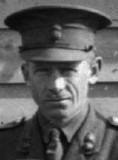
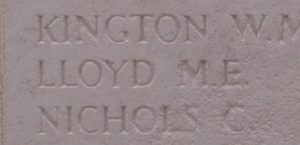
Solomon Llywarch, Private, 18064, Cheshire Regiment. Solomon was the son of Evan and Elizabeth Llywarch, of Fron, Meifod. He worked as a waggoner at Ceunant, Meifod prior to moving to South Wales to find work. Solomon enlisted at Pontypridd into the 9th Battalion, Cheshire Regiment soon after the outbreak of war. The battalion formed at Chester before moving to Salisbury Plain to join 56 Brigade, 19th (Western) Division. Solomon embarked for France with the battalion on 19 July 1915, and the entire 19th Division then moved to the Nursery Sector at Calonne for trench initiation alongside the Dehra Dun Brigade. The infantry battalions of the division then began carrying out the usual routines of rotating in the trenches: four days in the front line; four in support; and four in reserve, interspersed with training regimes and carrying out working parties and trench raids. Just south, the British launched a great offensive around the town of Loos on 25 September 1915, and the 19th Division was ordered to attack from its positions at the same time, to attempt to draw enemy attention away from the main battle area. The attacking battalions of the 19th Division were in place by 04.00, and then at 05.50 the men climbed out of their trenches to launch their assault, behind a gas and smoke screen. The assault was a disaster, and heavy casualties were suffered by the 19th Division for no gain. The battered division remained in the area over the coming months until being relieved in April 1916 and began to move south to the Somme sector, reaching Albert by 20 May. The Divisions infantry battalions then spent several periods behind the lines training for the forthcoming Somme offensive, before moving into support positions by 30 June. At 07.20 the following morning, 1 July 1916, the Somme offensive opened. In front of the 19th Division a number of huge underground mines were blown, and the Division followed up the opening assault from the Tara to Usna line towards the village of La Boiselle. On 1 August the Division began to move from the Somme front, arriving at Bailleul on 7 August before heading to a new sector near Messines. On 13 August the 9th Cheshire’s relieved the 9th RWF in the front line to begin its first tour in the Messines trenches. The trenches were found to be in a deplorable state, so the men began work on trench improvements, fitting raised duckboards and raising the parapets. Solomon was killed by artillery fire whilst carrying out this work on 16 September 1916. The 24-year-old has no known grave and is commemorated on the Ploegsteert Memorial, Belgium.
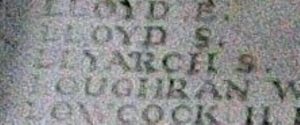
Matthew Henry Morris, Private, 55475, Royal Welsh Fusiliers. Matthew was the son of Thomas Marple Morris and Elizabeth Morris, of Cyfronydd Villa, Llanfair Caereinion. He worked as a waggoner at Lower Trefnant, Maesmawr, Guilsfield prior to marrying Alice Ellis of Llyndu, Guilsfield on 4 December 1912. Matthew enlisted into the Montgomeryshire Yeomanry at Welshpool soon after the outbreak of war and was posted to the 3/1st Battalion at Park Hall Camp, Oswestry for training. He was drafted to France in the winter of 1916-17, joining the 17th Battalion, Royal Welsh Fusiliers. The battalion was attached to 115 Brigade, 38th (Welsh) Division, which had moved to Ypres in September 1916 following its epic assault on Mametz Wood in July. The Division then took over the Canal Bank sector at Boesinghe. The infantry battalions of the Division then began carrying out the normal pattern of rotation in the trenches, four days in the front, four in support and four in reserve, whilst also working on trench improvement, digging new trenches, and also carrying out regular patrols and trench raids. On 31 July 1917 the Division launched its famous assault on the Pilckem Ridge, capturing Iron Cross and reaching its objective of the Steenbeek, then played a supporting role in the Battle of Langemarck. The Division was transferred to the Sailly-sur-la-Lys sector in September and remained in the area over the winter before being moved to positions north of Albert, at Bouzincourt Ridge, at the end of March 1918, relieving the battered 2nd and 47th Divisions. It held this sector, again carrying out minor operations and trench raids, over the coming months, before taking part in the great offensive of 21 August 1918, and began its advance towards the Hindenburg Line. The 17th RWF remained in reserve for the initial assault then at dawn on 23 August 1917 crossed the Ancre at Albert and relieved the 13th RWF from the front line. Matthew was killed in action just after the relief that morning. The 24-year-old has no known grave and is commemorated on the Vis-en-Artois Memorial, Haucourt, France.
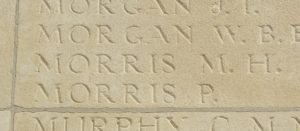
Francis Richards, 74192, Lance Corporal, Sherwood Foresters. Francis was the son of Thomas and Martha Ann Richards, of Pentricans, Pontrobert, Meifod. He worked as a waggoner at Forge Farm, Meifod prior to enlisting into the Royal Welsh Fusiliers at Welshpool on 29 November 1915. Francis was then posted to the 3rd Battalion, Royal Welsh Fusiliers at Litherland Camp, Liverpool for training, then embarked for France at Southampton on 10 May 1916, joining the 2nd Infantry Base Depot at Rouen. On 21 May 1916 Francis was posted to the 2nd Battalion, Royal Welsh Fusiliers, which was in the notorious Cambrin Sector, near Loos, attached to 19 Brigade, 33rd Division. On 22 June 1916 the Germans exploded a massive mine beneath the position held by B Company, 2nd RWF, which killed 54 men of the battalion, as well as trapping a number of British tunnellers underground. During the attempted rescue of one tunneller, a soldier of the 14th Welsh, Sapper Hackett was awarded the VC. At the beginning of July, the 33rd Division moved out of the sector and began to move into the Somme area. By 16 July the 2nd RWF were bivouacked in the newly captured Mametz Wood and moved to Bazentin-le-Petit two days later, to take part in the assault on High Wood. Francis was shot in the left arm near High Wood on 20 July 1915 and was evacuated via the 101st Field Ambulance to the 9th General Hospital at Rouen, before returning to England to recover. He embarked again at Southampton on 18 January 1917 and was posted to the 15th Battalion, Royal Welsh Fusiliers, which was at Ypres attached to 115 Brigade, 38th (Welsh) Division. Francis took part in the Divisions assault on Pilckem Ridge on 31 July 1917, then in September was transferred to the 19th Battalion, Royal Welsh Fusiliers, which was attached to 119 Brigade, 40th (Bantam) Division. He then took part in the famous attack by the Division on Bourlon Wood during the opening phase of the Battle of Cambrai on 20 November 1917. The Division wintered in the Flesquières Salient, then in January Francis returned home on two weeks leave. Soon after returning to France the 19th RWF was disbanded and on 6 April, he was posted to the 10th Battalion, Sherwood Foresters (Nots & Derby Regiment), which was at Millonvillers, attached to 51 Brigade, 17th (Northern) Division and was rebuilding following heavy losses the previous month. The Division then took over the line in the Mesnil Sector, just north of the 38th (Welsh) Division, and held the sector before taking part in the great offensive of 21 August 1918, pushing forward towards Bapaume by the end of the month, then driving the Germans back towards the Hindenburg Line. At the beginning of October, the mighty Hindenburg Line was broken, and the 17th Division swept towards Cambrai, fighting at the Battle of Cambrai on 8 October, and then north-east through northern France, towards Le Cateau, during the Pursuit to the Selle. By 12 October the 17th Division was east of the Selle near Inchy. On the following day the 10th Sherwood Foresters came under attack by a number of snipers, firing from ruined buildings in Neuvilly. Francis was killed in action that day, 13 October 1918. The 27-year-old is buried in Montay-Neuvilly Road Cemetery, Montay, France.
Griffith Ellis Ridge, Private, 203111, Royal Welsh Fusiliers. Griffith was the son of Hugh and Margaret Ridge, of Llyndu Cottage, Meifod. He worked as a farm labourer at Keel prior to the war. Griffith enlisted into the Montgomeryshire Yeomanry at Welshpool on 21 September 1914 and was posted to Park Hall Camp, Oswestry before being transferred to the 4th Battalion, Royal Welsh Fusiliers on 17 December 1916. On 18 December 1916 Griffith arrived in France, joining No 5 Infantry Base Depot, at Rouen, and on 5 January 1917 was posted to the 1/4th Battalion, Royal Welsh Fusiliers, which was at Ypres, serving as the Pioneer Battalion to the 47th (2nd London) Division. Over the coming weeks, Griffith worked with the battalion at Railway Dugouts, but on 14 April was among three men wounded, suffering gunshot wounds to his arm, and was evacuated to hospital before returning to England for treatment. After recovering, he returned to No 5 Infantry Base Depot, and from there was posted to the 19th Battalion, Royal Welsh Fusiliers on 24 September 1917. The battalion was attached to 119 Brigade, 40th (Bantam) Division, and Griffith joined up with his new battalion in time to take part in the terrible fighting for Bourlon Wood, during the Battle of Cambrai. He was wounded at Bourlon Wood on 24 November, and hospitalised again, before re-joining the battalion. The 19th RWF was disbanded on 6 February 1918, and its men posted to other battalions. Griffith was posted to Hawke Battalion, 63rd (Royal Naval) Division, which was on the Somme. On 25 May 1918 Griffith was with Hawke Battalion, which was bivouacked at Engelbelmer, in Divisional Reserve, when their camp was hit by a dozen German shells, causing eleven casualties, and killing Griffith and another man. Griffith was 21 years old when he was killed that day and is buried in Engelbelmer Communal Cemetery Extension, France.
Harry Cureton Roberts, Lieutenant, Montgomeryshire Yeomanry. Harry was the son of David and Margaret Roberts, of Dyffryn, Meifod. He worked on his parent’s farm prior to the war. Harry was a serving member of the Montgomeryshire Yeomanry when war was declared and was the Staff Quartermaster Sergeant. On 5 August 1914 the Montgomeryshire Yeomanry was mobilised at Welshpool, as part of the South Wales Mounted Brigade, before moving via Hereford to Thetford, to join the 1st Mounted Division. Harry was discharged to a commission as Second Lieutenant with the Montgomeryshire Yeomanry on 5 January 1916. On 4 March 1916 the 1st Mounted Division sailed for Egypt to join the EEF. On 4 March 1917 the battalion merged with the Welsh Horse Yeomanry to form the 25th (Montgomery & Welsh Horse Yeomanry) Battalion, Royal Welsh Fusiliers, as part of the newly formed 231 Brigade, 74th (Yeomanry) Division. The Division assembled in Egypt as part of the EEF, before crossing the Suez Canal into the Sinai, and saw its first major action during the Second Battle of Gaza. The battle was a failure, and the EEF was re-organised under a new commander, Sir Edmund Allenby, before launching the Third Battle of Gaza on the night of 31 October 1917. This assault was launched along a winder front, running from Gaza to Beersheba, and this time the EEF prevailed, opening the door to Jerusalem, which surrendered on 8 December. The offensive then continued into the country north of Jerusalem. On 20 December, XXI Corps launched its attack towards the maritime plain, crossing the River Auja, which was in flood after the rain of the previous days, and captured all of their objectives with little resistance. On the night of 26-27 December, the Turks counter-attacked and on the following morning, 27 December 1917, the 25th RWF assaulted Hill 1910 in conjunction with the 24th Welsh. Harry was killed in action during the assault that day. The 32-year-old is buried in Jerusalem War Cemetery, Israel.
John Evan Rogers, Private, 202930, Royal Welsh Fusiliers. John was the son of John and Sarah Ann Rogers, of Lower Brynygroes, Meifod. He worked as a farm labourer prior to enlisting into the 3/1st Battalion, Montgomeryshire Yeomanry at Welshpool on 18 April 1916 and was posted to park Hall Camp, Oswestry for training. John embarked at Southampton for France on 8 December 1916 and was posted to C Company of the 1/4th Battalion, Royal Welsh Fusiliers. The battalion was the Pioneer Battalion to the 47th (2nd London) Division which, in October 1916, had moved north to Belgium from the Somme sector, taking over a section of the front line running south from Hill 60 to the Ypres-Comines Canal. The Division remained here until taking part in the Battle of Messines Ridge on 7 June 1917. The men of the 4th RWF worked tirelessly during the battle to repair roads and to extend the Spoil Bank tram line. In September 1917 the 47th Division was relieved and moved south, taking over positions some 2,000 yards north of Arras. The men of the 4th RWF again began work on road repairs, in preparation for the forthcoming Battle of Cambrai, which was launched on 20 November 1917. The battle raged until 6 December, by which time a German counterattack had been quashed and the 47th Division wintered in the area, stationed near Metz. By March 1918 the Division was situated near St. Quentin, and faced the German Spring Offensive here on 21 March 1918, seeing heavy fighting over the coming days as it was forced to withdraw across the old Somme battlefields towards Albert. John was killed in action during the second day of the withdrawal, on 22 March 1918. The 20-year-old has no known grave and is commemorated on the Arras Memorial, France.
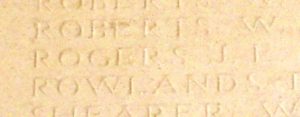
Howard Owen Thomas, Private, G/36126, East Surrey Regiment. Howard was the son of Oliver Thomas and Matilda Thomas (nee Buzza), of the White Horse Hotel, 21 Church St, Oswestry. He worked as an assistant hotel keeper at the Lion Hotel, Meifod prior to the war. Howard then enlisted at Welshpool on 4 February 1916 into the Royal Flying Corps and was placed on the Army Reserve. He was mobilised on 18 January 1917 and was sent to Farnborough for training, where he was appointed Airman 2nd Class on 15 May. On 12 July 1917 Howard was compulsorily transferred to the army, joining the 112th Training Reserve Battalion. He was posted to Catterick on 22 February 1918, joining the 3rd Battalion, East Surrey Regiment before embarking for France on 29 May 1918, joining the 8th Battalion, East Surrey Regiment on 5 July. The battalion was attached to 55 Brigade, 18th (Eastern) Division, which was holding the line in the Senlis Sector of the Somme. On 21 August 1918 the Allies launched a general offensive along much of the Western Front. The 18th Division attacked from its positions in conjunction with the 38th (Welsh) Division, and at dawn on 22 August 1918 the 8th East Surrey’s attacked to the south of Albert, becoming caught up in terrible street fighting as they cleared their way through the town. As the eastern side of the town was reached, machine-gun fire reigned down on the assaulting troops from the direction of the old Tara-Usna Line, but despite this all of the day’s objectives were met. Howard was killed in action during this fighting that day. The 21-year-old was originally buried in a mass grave on the battlefield, with a number of other men of his battalion killed at the same time. After the war this grave was exhumed and the remains were reburied in Ovillers Military Cemetery, France.
John Henry Thomas, Lance Corporal, 355138, Royal Welsh Fusiliers. John was the son of William and Elizabeth Thomas, of Cefngoleu, Meifod. He worked as a farm labourer for his father prior to the war. John had enlisted into the Montgomeryshire Yeomanry at Park View, Llanfyllin on 26 February 1914, and attended the Annual TA Summer Camp that year. On 5 August 1914 the Montgomeryshire Yeomanry was mobilised at Welshpool, as part of the South Wales Mounted Brigade, before moving via Hereford to Thetford, to join the 1st Mounted Division. On 4 March 1916 the 1st Mounted Division sailed for Egypt to join the EEF. On 4 March 1917 the battalion merged with the Welsh Horse Yeomanry to form the 25th (Montgomery & Welsh Horse Yeomanry) Battalion, Royal Welsh Fusiliers, as part of the newly formed 231 Brigade, 74th (Yeomanry) Division. The Division assembled in Egypt as part of the EEF, before crossing the Suez Canal into the Sinai, and saw its first major action during the Second Battle of Gaza. The battle was a failure, and the EEF was re-organised under a new commander, Sir Edmund Allenby, before launching the Third Battle of Gaza on the night of 31 October 1917. This assault was launched along a winder front, running from Gaza to Beersheba, and this time the EEF prevailed, opening the door to Jerusalem. The Division then took part in the drive north into Syria, but as a result of the heavy losses suffered in France, following the launching of the three German Spring offensives from 21 March 1918, was sent to France, landing in Marseilles on 7 May 1918. The Division underwent a system of training, to prepare it for the vastly different conditions on the Western Front, before taking over a section of the front in the St. Floris Sector. On 10 July 1918 the 25th RWF moved into the front line here for the first time, to begin its first tour on the Western Front. John was wounded in the head whilst in the front line here on 20 July and was evacuated to the 39th Stationary Hospital at Aire, where he died of his wounds on 23 July 1918. The 21-year-old is buried in Aire Communal Cemetery, France.
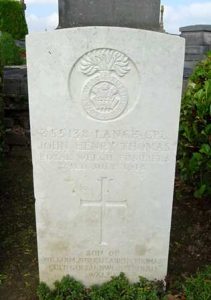
David Wilding, Private, 291288, Royal Welsh Fusiliers. David was the son of John and Ann Wilding, of Glascoed Bank, Meifod. He worked as a waggoner prior to the war and resided at New Bridge, Meifod. David enlisted into the 7th Battalion, Royal Welsh Fusiliers at Welshpool on 27 November 1915 and was posted to the 3/7th Battalion, Royal Welsh Fusiliers at Park Hall Camp, Oswestry for training. He embarked at Devonport for Egypt on 21 May 1916 and upon disembarking was posted to the 1/7th Battalion, Royal Welsh Fusiliers, which was attached to 158 Brigade, 53rd (Welsh) Division. The Division had been evacuated from Gallipoli in December 1915, moving to Egypt to join the EEF, and helped guard the Suez Canal before taking part in operations to drive the Turks out of the Sinai. The EEF then turned its attention onto driving the Turks out of Palestine, and on 26 March 1917 launched its first offensive against the coastal city of Gaza, which guarded the road to Jerusalem. Initial gains during the day were lost when the assaulting divisions lost touch with each other, and communication broke down when a thick fog cloaked the battlefield. David was wounded in the shoulder during the assault but was then posted as missing in action. No trace of him was ever found and he was later adjudged to have been killed in action on that date. The 29-year-old has no known grave and is commemorated on the Jerusalem Memorial, Israel. His name appears to have been a later addition to the Meifod war memorial, as it is on a plate rivetted to the bottom.
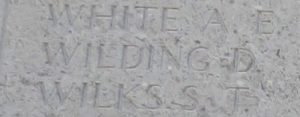
John Ephraim Williams, Sapper, 82353, Royal Engineers. John was born at Birkenhead in 1886, the son of John and Catherine Williams. Both of his parents were from Meifod and by 1891 the family was living back in the village. John was lodging with his sister Mary and her husband, Frank Williams, at 4 Short Street, Court Street, Briton Ferry by 1911, where he worked as a carter. He married Miriam Taylor there on 6 April 1912, and the couple returned to Meifod, setting up home at Bronymaen Cottage. John enlisted at Neath into the Royal Engineers soon after the outbreak of war and was posted to the 124th Field Company, Royal Engineers. The company was formed as part of the newly raised 43rd (Welsh) Division, training with the division in North Wales until it moved to Morn Hill, Winchester in the summer of 1915 and was renumbered to the 38th (Welsh) Division. The entire division then embarked for France in December 1915 and moved to the Nursery Sector near Fleurbaix for trench initiation alongside the Guards Division. The Division then held a sector of the line near Cuinchy before marching south to the Somme sector in June 1916 to take part in the assault on Mametz Wood. The first attack on the wood was launched on a two-battalion front on 7 July, but failed, and the Divisional Commander, Sir Ivor Philipps, was replaced before the Division attacked again on a two Brigade front on 10 July 1916. After two days of ferocious hand-to-hand fighting, the wood was cleared up to its northern edge, before the battered Division was relieved. It then took over a section of the front at Hébuterne before moving to the Ypres Salient and taking over the Canal Bank sector at Boesinghe. The infantry battalions of the Division then began carrying out the normal pattern of rotation in the trenches, four days in the front, four in support and four in reserve, whilst also working on trench improvement, digging new trenches, and also carrying out regular patrols and trench raids. On 31 July 1917 the Division launched its famous assault on the Pilckem Ridge, capturing Iron Cross and reaching its objective of the Steenbeek. The 124th Company, RE followed up the infantry assault, with orders to keep up with the advance and to construct a series of strong points, in case of a counterattack by the Germans. John was killed in action that day. The 31-year-old is buried in Artillery Wood Cemetery, Belgium.
John Sidney Williams, Sergeant, 355337, Royal Welsh Fusiliers. John was the son of Lot and Eliza Williams, of Old Public, Pontrobert. He was a grocer who had married Margaret Williams in 1908 and the couple ran Waterloo Shop, at Meifod. John enlisted into the Montgomeryshire Yeomanry at Welshpool on 26 April 1915 and was posted to the 3/1st Battalion, Montgomeryshire Yeomanry at Park Hall Camp, Oswestry for training. He embarked for Egypt at Devonport on 12 January 1917 and upon disembarking at Alexandria was posted to the newly formed 25th Battalion, Royal Welsh Fusiliers. The battalion formed in Egypt on 4 March 1917 from the merger of the Montgomeryshire Yeomanry and the Welsh Horse Yeomanry and joined the newly formed 231 Brigade, 74th (Yeomanry) Division. The Division assembled in Egypt as part of the EEF, before crossing the Suez Canal into the Sinai, and saw its first major action during the Second Battle of Gaza. The battle was a failure, and the EEF was re-organised under a new commander, Sir Edmund Allenby, before launching the Third Battle of Gaza on the night of 31 October 1917. This assault was launched along a winder front, running from Gaza to Beersheba, and this time the EEF prevailed, opening the door to Jerusalem. John was badly wounded during the assault and died of his wounds on the following day, 1 November 1917. The 33-year-old is buried in Beersheba War Cemetery, Israel.
Charles Watkin Williams-Wynn, Second Lieutenant, Coldstream Guards. Charles was the son of Arthur Watkin Williams-Wynn and Alice Mary Williams-Wynn (nee Wentworth-Fitzwilliam), of Coed-y-Maen, Llansantffraid-ym-Mechain. He was commissioned into the 1st Battalion, Coldstream Guards just prior to the outbreak of war and embarked at Southampton for France with the battalion on 13 August 1914 aboard the SS Dunvegan Castle. The battalion was attached to the 1st (Guards) Brigade, 1st Division of the BEF and moved to Mons, taking part in the opening actions of the war when the Germans attacked the city. The BEF was then forced to withdraw south to the Marne, where the German drive on Paris was stopped, before advancing north to the Aisne where the Germans were forced to entrench. The BEF then moved north, taking up positions to cover the city of Ypres and on 19 October 1914 the Germans attacked Ypres for the first time, in an attempt to break through Belgium to capture the channel ports. The BEF came under intense pressure over the coming days, fighting side-by-side with their Belgian and French Allies as the Germans sent in wave upon wave of infantry attacks. The 1st Division was dug in eat of Ypres, astride the Menin Road around Gheluvelt and on 29 October 1914 was hit by an overwhelming frontal assault. Charles was killed in action during the terrible fighting that day. The 18-year-old was originally buried on the battlefield, but his grave was later identified, and he was re-buried in Perth Cemetery (China Wall), Belgium after the Armistice.
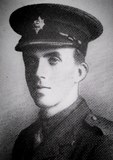
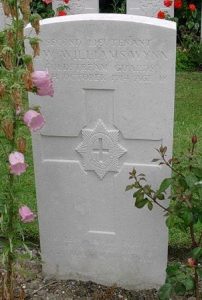
George Horace Wood, Private, United States Army. George was the son of Thomas Wood and Sarah Jane Wood (nee Jones), of Forge Mill, Pontrobert. On 15 January 1910 he left Britain for New York aboard the White Star liner RMS Celtic to start a life in the New World. Following the outbreak of war, George enlisted at New York into the 18th Infantry Regiment, 1st Division of the United States Expeditionary Force. The Division was known as the Big Red One, after its battle insignia. The first units sailed from New York City and Hoboken, New Jersey, on 14 June 1917, some landing at St. Nazaire, France, and some at Liverpool. The entire Division had assembled in France by December 1917. George was killed during the American capture of Soissons on 18 July 1918. The 28-year-old is buried in Plot B, Row 36, Grave 1, in Oise-Aisne American Cemetery, France.
World War Two, 1939-1945
Geraint Clement Davies, Lieutenant, 186938, Welsh Guards. Geraint was born on 21 November 1918. the son of The Right Honourable Clement Davies, Q.C., M.P. and of Jane Elizabeth Clement Davies (nee Davies) of Plas Duffryn, Meifod. He was educated at Radley College and then studied for his B.A. at Cambridge prior to the war, becoming a Batchelor of Law. Geraint was commissioned from the Officer Training Corps into the Welsh Guards in March 1941 and was posted to the 3rd Battalion, Welsh Guards. He was accidentally killed whilst on a training exercise on Salisbury Plain on 4 February 1943. The remains of the 24-year-old were brought home and he was buried with his sister, Mary, in Saint Tysilio and Saint Mary’s Churchyard, Meifod. His sister, Mary, had died on active service in 1941, whilst his father later became leader of the Liberal Party.
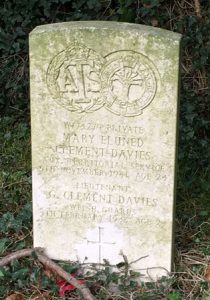
Mary Eluned Clement Davies, Private, W/74279, Auxiliary Territorial Service. Mary was born on 20 February 1917, the daughter of The Right Honourable Clement Davies, Q.C., M.P. and of Jane Elizabeth Clement Davies (nee Davies) of Plas Duffryn, Meifod. She enlisted into the Auxiliary territorial Service soon after the outbreak of war. Mary died, apparently of suicide, at Queen’s Camp, Guildford, Surrey on 5 November 1941. The remains of the 24-year-old were brought home for burial in Saint Tysilio and Saint Mary’s Churchyard, Meifod. Her brother, Geraint, died during a training accident in 1943. Their father later became leader of the Liberal Party.

Emlyn Alwyn Evans, Lance Corporal, 14406793, Welch Regiment. Emlyn was born on 12 June 1924, the son of John Rees Evans and Margaret Evans (nee Jones), of Meifod. He enlisted into the army and was posted to the 1/5th Battalion, Welch Regiment, which was attached to the 53rd (Welsh) Division. The battalion was mobilised at the outbreak of war, when the Division moved to Northern Ireland to begin garrison duties. The Division then moved to Pembroke Dock, before moving again to the south of England, where it trained in readiness for the D-Day Landings. On 24 June 1944 the 7th RWF left England for Normandy, and landed at La Riviere near Ver Sur Mer. The Division then took part in heavy fighting over the coming weeks, as part of the effort to break-out of the Normandy beachhead, seeing heavy fighting at Évrecy, before starting the epic advance through Northern France into Belgium and Holland. On 15 September the Division forced the crossing of the Junction Canal North of Lommel, and continued to push westwards towards Elst, between Nijmegen and Arnhem, during Operation Market Garden. On 22 October the Division launched its famous assault on ‘s-Hertogenbosch, before continuing its advance to the German frontier. Between December 1944 and January 1945, the Division took part in the Battle of the Bulge, helping in the counterattack which helped save the Americans, who were under heavy pressure, then after the German offensive was broken, took part in heavy fighting to enter the Rhineland. Emlyn was killed during the advance into the Reichswald Forest on 11 February 1945. The 20-year-old is buried in Reichswald Forest War Cemetery, Germany.
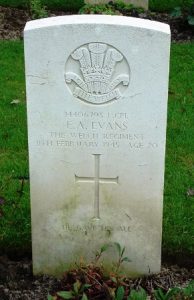
Ivor Llewelyn Evans, Corporal, 4194433, Royal Welch Fusiliers. Ivor was the son of John Rees Evans and Winnie Edith Evans (nee Jones), of Meifod. He enlisted into the army and was posted to the 2nd Battalion, Royal Welch Fusiliers. The Battalion was part of the 29th Independent Infantry Brigade and in 1942, it fought in the Battle of Madagascar, before being transferred to the South-East Asian Theatre. In 1944, the brigade became part of the 36th Infantry Division and trained in amphibious assault operations before entering Burma on 12 February 1944. The Division returned to India in June 1944 before flying into North Burma in August 1944 and advancing south to Mandalay. Ivor was killed on the road to Mandalay on 24 April 1945. The 24-year-old was originally buried in Meiktila Christian War Cemetery, but in 1953 the war graves in the cemetery were exhumed and re-interred in Taukkyan War Cemetery, Myanmar.
William Anwyl Jones, DFC, Flight Lieutenant, 146013, Royal Air Force Volunteer Reserve. William was born on 27 November 1920, the son of William and Mary Olwen Jones, of Bronymaen, Meifod. After training as a navigator, he was commissioned as Flight Lieutenant into the Royal Air Force Volunteer Reserve on 24 October 1943 and was posted to 109 Squadron, RAF. The Squadron had reformed on 10 December 1940 at RAF Boscombe Down operating a variety of aircraft and was a specialist unit whose role was to identify German radio beams and to develop methods to jam them, as well as to develop wireless and radar navigation aids for Bomber Command. In 1942 the squadron moved to RAF Stradishall where it was equipped with the de Havilland Mosquito light bomber fitted with Oboe, a modern bomb-aiming device. The Squadron then moved to RAF Wyton where it operated as part of the Pathfinder Force. The Squadron operated on pathfinder duties for the rest of the war until the last raid on Berlin on 21 April 1945. It then operated to assist with the accurate dropping of supplies in Holland. On 6 March 1945, William took off from RAF Little Staughton aboard Mosquito XVI, Serial PF429, on an operation to mark enemy transport and troops. Whilst flying over Holland, the Mosquito collided with another of the flight and damaged its tail, before hurtling to the ground out of control, killing William and his pilot, George Miller Smith. William was 24 years old when he was killed during the loss of his Mosquito that day. He has no known grave, so is commemorated on the Runnymede Memorial, Surrey. He was posthumously awarded the Distinguished Flying Cross in April 1945.